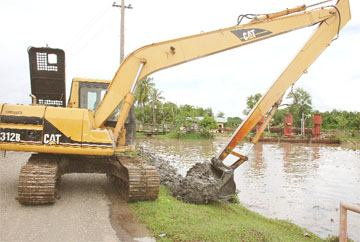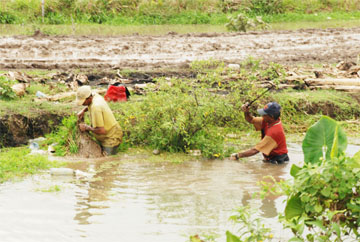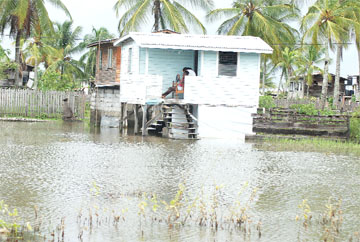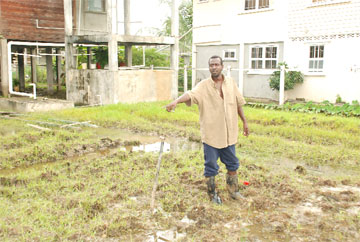-livestock, rice crops among losses
Photos by Jules Gibson
Floodwaters began receding in some villages along the East Coast Demerara (ECD) yesterday, leaving damaged homes, lost crops and dead livestock in their wake.
Heavy rainfall over the last few days has been responsible for flashfloods in some low-lying villages along the coast, which has left some residents recalling the Great Flood of 2005. Stabroek News travelled to Ann’s Grove, East Coast and Cane Grove, Mahaica yesterday to observe the effects of the recent flooding on villagers living along the coastland. While some of them are trying to cope with the flooding, for others it has been devastating after heavy losses.

Cows, sheep, goats and other livestock could be seen wandering along the Railway Embankment Road at Melanie and villages farther along the coast. At approximately 12.54pm when Stabroek News passed by the Enmore/Haslington junction several cows could be seen in that area as well. While many motorists indicated that they are “trying to understand the situation,” the animals roaming freely along the major roadways posed a serious threat to road safety. “We don’t want our animals roaming about the road but we don’t have much of a choice. Our yards have water and many of us have already lost livestock to floodwater,” a farmer who lives at Melanie, Railway Embankment explained.

Low-lying areas in Ann’s Grove still had inches of water. However, most of the water had receded. Residents were cleaning the lower flats of their homes while carpets, curtains and furniture were placed outdoors for airing and drying.
Several yards located on and in the vicinity of Main Street, Ann’s Grove still had up to six inches of brown, stagnant water, which gave off a foul smell. Neverthe-less, several residents were seen moving through the water barefoot, many of them unaware of the possible dangers lurking in the foetid water. Many were shocked when told of the possibility of contracting leptospirosis.

Brenda Burke, a 64-year-old pensioner who lives with her 85-year-old father, told Stabroek News that the water has been in her yard since early last week. “I am an old woman and I have to take care of my father. Look I have up to six inches of water in my yard…if we need food or anything else I am the one who has to go through this stink water to get it,” Burke said from her Main Street home.

Another resident of Main Street, Molley Pompey, had to move into her neighbour’s unfinished house to escape the floodwaters. According to Pompey, her lower flat Lost 59 Main Street home had about five inches of water and she was only able to bail the last of the water out yesterday because it was then the water receded. The water, Pompey said pointing out her ruined possessions, damaged her furniture, carpet and other low-lying items. “I still remember the 2005 floods,” Pompey stated. “Imagine going to bed one night and waking up suddenly the next morning with one foot water in your bedroom…when I woke up last week I became frightened because I thought the same thing was going to happen all over again.”
Oswald Long, who lives at Cox and Main streets, Ann’s Grove, pointed to what remained of his garden. All that was visible were scattered weeds and clumps of dirt which indicated that a bank had been there before. “The water wash it all away…I used to sell to the people around here a make a small thing but now I can’t get nothing,” Long said shaking his head as he stared at his nonexistent garden.

Further, many Ann’s Grove residents expressed their concern about the lack of a proper water supply. The floodwater has contaminated the water main in the area and making the water useless to those who still have access to the commodity. “We depending on the rain water right now…without it many of use can’t bathe and wash,” one resident said.
Since last Friday, Stabroek News has visited a number of East Coast villages.
Conditions appeared worse the further we moved along the coast and many villagers said that personal hygiene was becoming a challenge. “I am embarrassed…but this is life and these are the conditions we are forced to live in on a daily basis,” an Ann’s Grove woman who requested anonymity said. “It is easier for men to answer calls of nature but for females it’s degrading.”
The woman told Stabroek News that many people in the area have latrines and they have been doing everything possible to prevent the faeces from escaping from the latrine pit into the water. “At night and even during the day the water forces us to relieve ourselves inside our house and then take it out to the latrine… some people have been stooping on their steps and urinating and defecating directly into the water,” she explained.
Another woman, whose yard still has several inches of water, described a similar challenge. She said that garbage disposal, especially of sanitary napkins and tampons proves a challenge in the present conditions. “The women in our house have to stack sanitary napkins in a tin on top of a table out in the yard and burn it… there are many who just dump it and let it float,” she said. “We feel demeaned, uncivilized…I am confused,” the woman said beginning to sob. “I am just so confused.”
Cane Grove
rice farmers
Rice farmers at Cane Grove have lost acres of crop due the flooding caused by heavy rainfall during the last week.
Cane Grove is a rice farming community along the coast. Farmers said yesterday that due to the mismanagement of the drainage and irrigation system in the area they will lose acres of crop this season.
While most of the floodwaters have receded from the residential area, rice fields are still swamped with two feet of additional water due mainly to an extra tube that has been placed beneath a dam separating the Melville rice fields from those located in the Savannah.
Farmers who own Melville rice fields explained that a member of the Cane Grove Water Users Association had placed a third tube, which has a 36-inch diameter, beneath the dam. The Savannah fields, they explained, are higher than the Melville fields and the tube is causing all the accumulated water from the rain to gush into their fields. “The fields over at the Savannah are higher so what is happening is the Melville fields have become a basin where all the water is accumulating,” Latchman Sarjue, a farmer who lost about 10 acres of rice, explained.
Ramgopaul, Group Promoter of the Cane Grove Water Users Association, told Stabroek News yesterday that he had placed the additional tube to drain the rice fields located in the Savannah. The Water Users Association, he explained, was established in 2003 and was responsible for maintaining secondary drainage and irrigation in the area. “There are 350 acres of rice field located in the Savannah and there are thousands located in Melville so he is draining hundreds at the cost of thousands,” Sarjue stated.
An engineer from the National Drainage and Irrigation Authority (NDIA) was inspecting the additional tube when Stabroek News visited the area shortly after 3 pm yesterday. “The floodwaters would drain off with the normal system but this man go and put this tube here and it making the flood worse… I will lose eight acres of crop because the plants already rotting and floating away,” Alleem said.
Alleem, 81, who has lived in Mahaica and farmed rice all his life, explained that it takes one and a quarter bags of paddy seeds to farm one acre of land. According to Ally, one bag of paddy seeds costs $6,500. “Most of our plants are two weeks old and at that stage they should have about two inches of water left in the field but because of the recent flooding we have two extra feet of water covering the plants,” he explained.
The man said that in all his years as a rice farmer he has never experienced such flooding.
“I don’t know what is happening…this flood and the one in 2005 is the worst ones I saw because in my time we would get flood but the water would run off before it damaged most of our crop,” the old man said.





